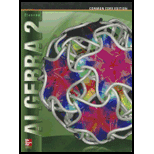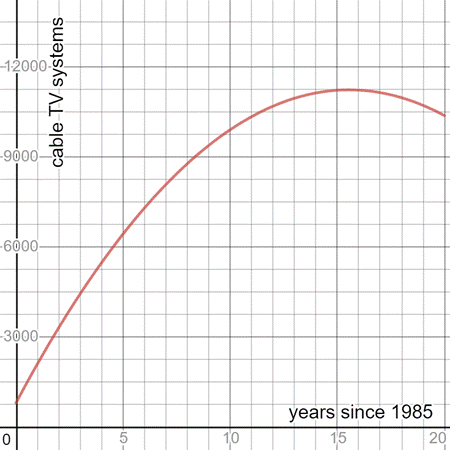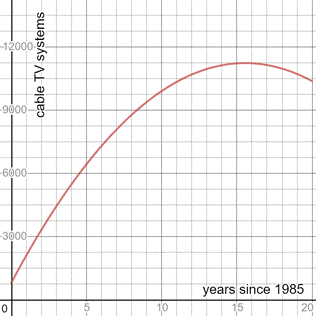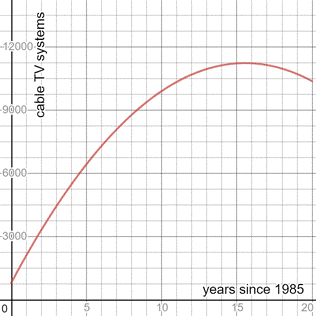
(a)
To Graph:
The given equation for the years 1985 to 2005
(a)
Explanation of Solution
Given:
The number of households in the United States with cable TV after 1985 can be modeled by the function
Calculation:
Number of years from 1985 to 2005 = 2005-1985 = 20 years
Let x -axis represent the number of years since 1985 and y -axis represent the number of households in the United States with cable TV after 1985.
Represent the equation

(b)
The turning points of the graph and its end behavior.
(b)
Answer to Problem 62SR
Turning point between t = 15 and 16
End behaviour:
Explanation of Solution
Given:
The number of households in the United States with cable TV after 1985 can be modeled by the function
Calculation:
From the graph in part (a) :
The graph has one turning point between :
t = 15 and 16 . The graph has related
The end behaviour of the graph :
(c)
To Find:
The domain of the function and eliminate the range of the function.
(c)
Answer to Problem 62SR
Domain = all real numbers
Explanation of Solution
Given:
Graph of the equation

Calculation:
From the equation
The graph takes all the y -values less than or equal to 11,225.
So, the
(d)
To Find:
What trends in households with cable TV does the graph suggest? Is it reasonable to assume that the trend will continue indefinitely?
(d)
Answer to Problem 62SR
The number of cable TV systems rose steadily from 1985 to 2000 , then it started to decline.
The trend will not continue indefinitely.
Explanation of Solution
Given:
Graph of the equation

Calculation:
From the graph , we can observe:
The number of cable TV systems rose steadily from t = 0 to t = 15 . That is , it rose steadily from 1985 to 2000 Then the graph goes down ,so after year 2000, the number of cable TV systems began to decline.
Since the number of cable TV systems cannot be negative. So, the graph cannot go below y=0.
So, the trend may continue for some years, but the number of cable TV systems cannot decline at this rate indefinitely.
Chapter 6 Solutions
Glencoe Algebra 2 Student Edition C2014
Additional Math Textbook Solutions
Elementary Statistics (13th Edition)
University Calculus: Early Transcendentals (4th Edition)
Intro Stats, Books a la Carte Edition (5th Edition)
A Problem Solving Approach To Mathematics For Elementary School Teachers (13th Edition)
Algebra and Trigonometry (6th Edition)
Basic Business Statistics, Student Value Edition
- A research study in the year 2009 found that there were 2760 coyotes in a given region. The coyote population declined at a rate of 5.8% each year. How many fewer coyotes were there in 2024 than in 2015? Explain in at least one sentence how you solved the problem. Show your work. Round your answer to the nearest whole number.arrow_forwardAnswer the following questions related to the following matrix A = 3 ³).arrow_forwardExplain the following termsarrow_forward
- Solve questions by Course Name (Ordinary Differential Equations II 2)arrow_forwardplease Solve questions by Course Name( Ordinary Differential Equations II 2)arrow_forwardInThe Northern Lights are bright flashes of colored light between 50 and 200 miles above Earth. Suppose a flash occurs 150 miles above Earth. What is the measure of arc BD, the portion of Earth from which the flash is visible? (Earth’s radius is approximately 4000 miles.)arrow_forward
- e). n! (n - 1)!arrow_forwardSuppose you flip a fair two-sided coin four times and record the result. a). List the sample space of this experiment. That is, list all possible outcomes that could occur when flipping a fair two-sided coin four total times. Assume the two sides of the coin are Heads (H) and Tails (T).arrow_forwarde). n! (n - 1)!arrow_forward
 Algebra and Trigonometry (6th Edition)AlgebraISBN:9780134463216Author:Robert F. BlitzerPublisher:PEARSON
Algebra and Trigonometry (6th Edition)AlgebraISBN:9780134463216Author:Robert F. BlitzerPublisher:PEARSON Contemporary Abstract AlgebraAlgebraISBN:9781305657960Author:Joseph GallianPublisher:Cengage Learning
Contemporary Abstract AlgebraAlgebraISBN:9781305657960Author:Joseph GallianPublisher:Cengage Learning Linear Algebra: A Modern IntroductionAlgebraISBN:9781285463247Author:David PoolePublisher:Cengage Learning
Linear Algebra: A Modern IntroductionAlgebraISBN:9781285463247Author:David PoolePublisher:Cengage Learning Algebra And Trigonometry (11th Edition)AlgebraISBN:9780135163078Author:Michael SullivanPublisher:PEARSON
Algebra And Trigonometry (11th Edition)AlgebraISBN:9780135163078Author:Michael SullivanPublisher:PEARSON Introduction to Linear Algebra, Fifth EditionAlgebraISBN:9780980232776Author:Gilbert StrangPublisher:Wellesley-Cambridge Press
Introduction to Linear Algebra, Fifth EditionAlgebraISBN:9780980232776Author:Gilbert StrangPublisher:Wellesley-Cambridge Press College Algebra (Collegiate Math)AlgebraISBN:9780077836344Author:Julie Miller, Donna GerkenPublisher:McGraw-Hill Education
College Algebra (Collegiate Math)AlgebraISBN:9780077836344Author:Julie Miller, Donna GerkenPublisher:McGraw-Hill Education





